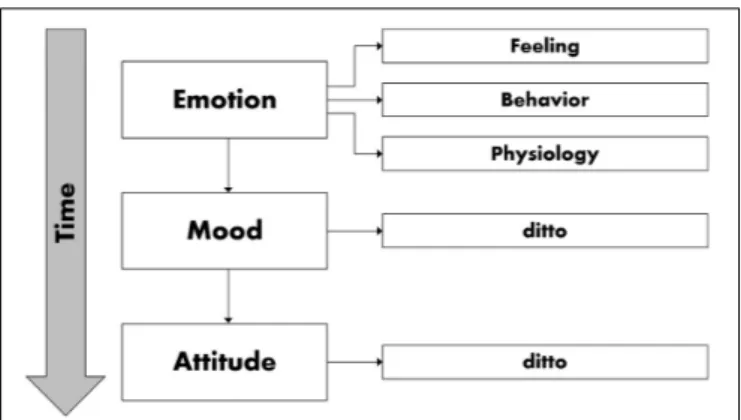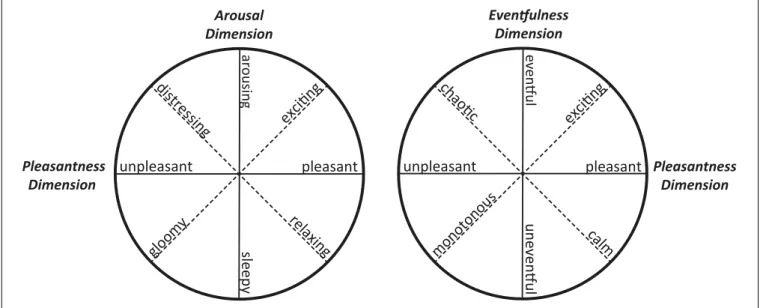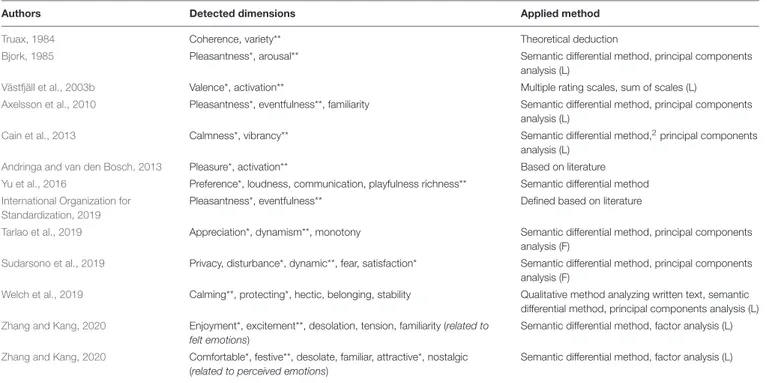doi: 10.3389/fpsyg.2020.573041
Edited by:
Bert De Coensel, Ghent University, Belgium Reviewed by:
Rory Allen, Goldsmiths, University of London, United Kingdom Jooyoung Hong, Singapore University of Technology and Design, Singapore
*Correspondence:
André Fiebig andre.fiebig@tu-berlin.de
Specialty section:
This article was submitted to Emotion Science, a section of the journal Frontiers in Psychology
Received: 16 June 2020 Accepted: 29 October 2020 Published: 20 November 2020 Citation:
Fiebig A, Jordan P and Moshona CC (2020) Assessments of Acoustic Environments by Emotions – The Application of Emotion Theory in Soundscape.
Front. Psychol. 11:573041.
doi: 10.3389/fpsyg.2020.573041
Assessments of Acoustic
Environments by Emotions – The Application of Emotion Theory in Soundscape
André Fiebig
1* , Pamela Jordan
2and Cleopatra Christina Moshona
11
Engineering Acoustics, Institute of Fluid Dynamics and Technical Acoustics, Technische Universität Berlin, Berlin, Germany,
2
Amsterdam Centre for Ancient Studies and Archaeology, University of Amsterdam, Amsterdam, Netherlands
Human beings respond to their immediate environments in a variety of ways, with emotion playing a cardinal role. In evolutionary theories, emotions are thought to prepare an organism for action. The interplay of acoustic environments, emotions, and evolutionary needs are currently subject to discussion in soundscape research.
Universal definitions of emotion and its nature are currently missing, but there seems to be a fundamental consensus that emotions are internal, evanescent, mostly conscious, relational, manifest in different forms, and serve a purpose. Research in this area is expanding, particularly in regards to the context-related, affective, and emotional processing of environmental stimuli. A number of studies present ways to determine the nature of emotions elicited by a soundscape and to measure these reliably. Yet the crucial question—which basic and complex emotions are triggered and how they relate to affective appraisal—has still not been conclusively answered. To help frame research on this topic, an overview of the theoretical background is presented that applies emotion theory to soundscape. Two latent fundamental dimensions are often found at the center of theoretical concepts of emotion: valence and arousal. These established universal dimensions can also be applied in the context of emotions that are elicited by soundscapes. Another, and perhaps more familiar, parallel is found between emotion and music. However, acoustic environments are more subtle than musical arrangements, rarely applying the compositional and artistic considerations frequently used in music. That said, the measurement of emotion in the context of soundscape studies is only of additional value if some fundamental inquiries are sufficiently answered:
To what extent does the reporting act itself alter emotional responses? Are all important affective qualities consciously accessible and directly measurable by self-reports? How can emotion related to the environment be separated from affective predisposition? By means of a conceptual analysis of relevant soundscape publications, the consensus and conflicts on these fundamental questions in the light of soundscape theory are highlighted and needed research actions are framed. The overview closes with a proposed modification to an existing, standardized framework to include the meaning of emotion in the design of soundscapes.
Keywords: soundscape, emotion, mood, appraisal, soundscape descriptors, affect, affective quality
INTRODUCTION
The field of soundscape focuses on how people experience their surrounding acoustic environments. This disciplinary position stands in contrast to the field of noise control, which focuses on human response to loudness and annoyance derived from environmental noise exposure. Soundscape’s broader view of sonic experience naturally points to the potential of incorporating findings from affect, emotion and appraisal research, particularly as both noise and soundscape fields already borrow related language and concepts (e.g., annoyance as a metric). Human responses to the (acoustic) environment may even be a reflection of evolved motivational and affective systems, promoting survival through preferences for certain environments and avoidance of others (van den Bosch et al., 2018). In order to place potential benefits stemming from emotion theory within the context of soundscape research and assessment, a brief review of emotion theory is first necessary.
Emotion Theory and Research
Emotions are a nearly constant aspect of the human phenomenal experience (Nielsen and Kaszniak, 2007), with states such as fear, happiness, boredom or amusement arising without conscious effort. With a subject–and lived experience–so familiar to everyone, the scientific approach to the study of affective and emotional states
1faces a challenge: any emotion theory must stand up to scientific rigor alongside any individual’s common- sense examination. This dual standard for research on emotion is likely one reason why an established theory of emotion does not yet exist (Müller and Reisenzein, 2013).
Even so, research abounds. Rottenberg et al. (2007) have traced the explosive growth of research during the past few decades, leading to new theories, methods, and findings. Coan and Allen (2007) substantiate this, highlighting the great diversity of methodological approaches that are currently driving emotion science. Many researchers address the issue of separating emotion from cognition, the relation of cause and effect, the distinction between basic and complex emotions, conscious and unconscious aspects of emotions, the relation between rationality and emotion, and the true origin of emotion. Some key texts along these lines will be highlighted in the discussion that follows.
Overall, emotions seem to be an integral concept that subsumes psychological stress and coping, uniting motivation, cognition and adaptation in a complex configuration (Lazarus, 1991).
As such, emotion is difficult to tackle by a single traditional psychological theory. Yet the study of the nature and structure of emotion has a long tradition that is still developing. It was recognized in the 19th century, the early days of psychophysics as a field, that body and mind are deeply intertwined. James had concluded that, if we consider a strong emotion and try to
1



![FIGURE 3 | Conceptual framework of the emotional construct of soundscape [adapted from ISO 12913-1 (International Organization for Standardization, 2014)].](https://thumb-eu.123doks.com/thumbv2/1library_info/3037677.74769/10.892.66.823.93.480/conceptual-framework-emotional-construct-soundscape-international-organization-standardization.webp)